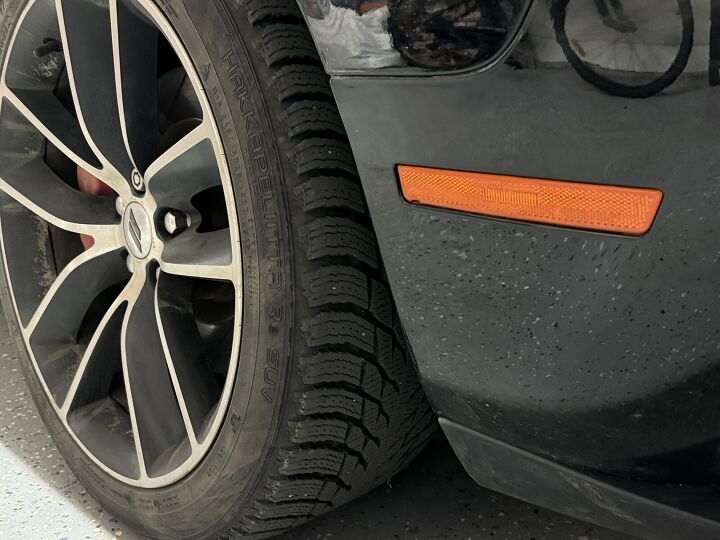Stuff We Use: Smoked Side Markers

On our never-ending quest to improve this place by listening to feedback from the B&B, we are taking a new tack with these product posts, choosing instead to focus on items we use and have purchased with our own meager income. After all, if we’re giving you the truth about cars, we ought to give you the truth about car accessories.
This one’s a little bit different than some of the other Stuff We Use missives which pass through our domain name twice a month. Instead of a universal product like battery boosters or jack stands, we’ll walk ya through the installation of an accessory placed on one of our cars just the other week.
Styling is a perpetually subjective thing, with some of us preferring a completely standard look to our hoopties while others enjoy something that’s just a little bit different than what’s available on the showroom floor. The writer is definitely in the latter camp, though only to a point. You won’t find stick-on chrome from Manny, Moe, & Jack on any of my whips, nor will the make or model be emblazoned on the windshield in foot-high stickers. If something I’ve added (or removed) from my car makes onlookers question if it rolled out of the factory that way, all the better.
First, a dose of history. Back in 1968, federal regulators decreed that new cars on our nation’s roads must abide by a new requirement for side-marker lights, appearing as amber colored lamps up front and red ones for the rear. This caused consternation in design studios, since adding these markers to some cars of the day was akin to taking a Sharpie to the Mona Lisa. Ok, that’s being a bit dramatic – but the point stands.
Some brands tried to stick it to The Man by only adhering to the letter of the law, begrudgingly placing the tiniest of amber/red side markers on their cars. The 1968 Dodge Charger is a perfect example of this thumb-in-the-eye to government. Still, someone in Washington must have twisted some arms (or at least defined a minimum number of square inches for side markers) because check out the amber/red honkers on the Charger just one model year later.
These days, modern LED technology makes it easy to incorporate these federally mandated units into a car’s design, with creative ideas cropping up like kudzu. Some modern machines, like the post-facelift Dodge Charger, did a respectable job of incorporating the illumination into its styling cues by having them trace the outline of front and rear wheel arches. But yer author’s five-year-old Dodge Challenger never received such a treatment, leaving what amounts to a set of amber and yellow popsicle sticks glued to the side of his car.
Enter the smoked lenses cribbed off the internet. Available from common sources like Amazon or eBay Motors, these things are intended to rid my car of the side marker scourge and blend in much more seamlessly with the Pitch Black paintwork. They arrived decently quickly through regular mail, showing up in a box that had been wrapped several times in plastic to discourage theft, a sadly prevalent occurrence in your humble author’s experience with envelopes arriving ripped asunder and magazines shredded beyond readability. This is not an issue with couriers in our area.
Anyway, installing these lights couldn’t have been easier. Gone are the days of my father’s 1978 Blazer whose side markers were affixed with exposed silver Phillips head screws, replaced with far more discreet clips on the lights’ anterior sides. Simply sliding under the Challenger was enough to find the clips for its rear lights, requiring an easy push on its fore fastener which permitted the rear fastener to slide right out. All that remained was unplugging the light from its factory harness, a task slightly easier said than done thanks to five years of accumulated road grime.
With the factory light removed, installation – as they used to say in Chilton’s manuals – was reverse of the removal. Not s single tool was required to make this upgrade, a delight in this modern age where some cars require the disassembly of their front fascias in order to replace a headlight bulb. The aftermarket lamp appears completely black when off, shining a bright red when illuminated. We’ve all seen aftermarket LED stuff go dim after a few months of use, so I’ll be keeping an eye on these things for any shenanigans. All’s well so far.
Up front on the Challenger, removal of the factory lights was equally simple – on the passenger side. Reaching down through the engine compartment to that side’s lamp and pushing out the fasteners was as easy as it was on the car’s aft quarters, but the driver side required removing the cone air filter and sticking my arm down through the intake box. This took but a moment of logical thought, though I am confident there are ample numbers of YouTube tutorials on this topic. The fasteners on this final lamp were easy to manipulate once I snaked my arm down through the intake and around to the back of its front fender.
So far, I give this upgrade full marks for ease of installation and satisfaction with results. Take that, regulators of 1968!
[Images: The Author]
Become a TTAC insider. Get the latest news, features, TTAC takes, and everything else that gets to the truth about cars first by subscribing to our newsletter.

Matthew buys, sells, fixes, & races cars. As a human index of auto & auction knowledge, he is fond of making money and offering loud opinions.
More by Matthew Guy
Latest Car Reviews
Read moreLatest Product Reviews
Read moreRecent Comments
- Jeanbaptiste 2022 Tesla model 3 performance ~35000 miles tires - ~$1000ish. Several cabin filters ~$50
- El scotto No rag-top, no rag-top(s) = not a prestigious car brand. Think it through. All of the high-end Germans and Lexus have rag-tops. Corvette is really its own brand.World-leading engines. AMG, M, S and well Lexus is third-world tough. GM makes one of the best V-8s in the world in Bowling Green. But nooooo, noooo, we're GM only Corvettes get Corvette engines. Balderdash! I say. Put Corvette engines in the top-tier Cadillacs. I know GM could make a world-class 3.5 liter V-6 but they don't or won't. In the interior everything that gets touched, including your butt, has to feel good. No exceptions.Some think that those who pay above MSRP and brag about it are idiots. Go the opposite direction, and offer an extended 10-year 100,000-mile factory warranty. At a reasonable price. That's Acura's current business model.
- Carrera 2014 Toyota Corolla with 192,000 miles bought new. Oil changes every 5,000 miles, 1 coolant flush, and a bunch of air filters and in cabin air filters, and wipers. On my 4th set of tires.Original brake pads ( manual transmission), original spark plugs. Nothing else...it's a Toyota. Did most of oil changes either free at Toyota or myself. Also 3 batteries.2022 Acura TLX A-Spec AWD 13,000 miles now but bought new.Two oil changes...2006 Hyundai Elantra gifted from a colleague with 318,000 when I got it, and 335,000 now. It needed some TLC. A set of cheap Chinese tires ($275), AC compressor, evaporator, expansion valve package ( $290) , two TYC headlights $120, one battery ( $95), two oil changes, air filters, Denso alternator ( $185), coolant, and labor for AC job ( $200).
- Mike-NB2 This is a mostly uninformed vote, but I'll go with the Mazda 3 too.I haven't driven a new Civic, so I can't say anything about it, but two weeks ago I had a 2023 Corolla as a rental. While I can understand why so many people buy these, I was surprised at how bad the CVT is. Many rentals I've driven have a CVT and while I know it has one and can tell, they aren't usually too bad. I'd never own a car with a CVT, but I can live with one as a rental. But the Corolla's CVT was terrible. It was like it screamed "CVT!" the whole time. On the highway with cruise control on, I could feel it adjusting to track the set speed. Passing on the highway (two-lane) was risky. The engine isn't under-powered, but the CVT makes it seem that way.A minor complaint is about the steering. It's waaaay over-assisted. At low speeds, it's like a 70s LTD with one-finger effort. Maybe that's deliberate though, given the Corolla's demographic.
- Mike-NB2 2019 Ranger - 30,000 miles / 50,000 km. Nothing but oil changes. Original tires are being replaced a week from Wednesday. (Not all that mileage is on the original A/S tires. I put dedicated winter rims/tires on it every winter.)2024 - Golf R - 1700 miles / 2800 km. Not really broken in yet. Nothing but gas in the tank.







































Comments
Join the conversation
I did them on my C7 because somehow GM managed to build LED markers that fail after only 6 years. These are brighter then OEM despite the smoke tint look.
I got them here: https://www.corvettepartsandaccessories.com/products/c7-corvette-oracle-concept-sidemarker-set?variant=1401801736202
Modifications are funny things. I like the smoked side marker look - however having seen too many cars with butchered wire harnesses, I don't buy cars with ANY modifications. Pro-tip - put the car back to stock before you try and sell it.